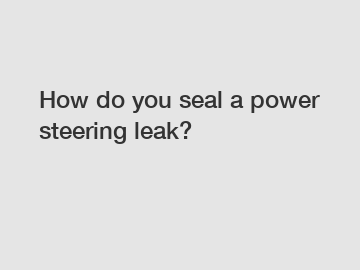How do you seal a power steering leak?
How do you seal a power steering leak?
Power steering leaks can be a common issue in vehicles, leading to decreased performance and potential safety risks. The power steering system plays a critical role in assisting the driver in steering the vehicle, and any leaks need to be addressed promptly to prevent further damage. If you're wondering how to seal a power steering leak, this article will guide you through the process.
Identifying the Power Steering Leak.

The first step in sealing a power steering leak is to identify its source. Common signs of a power steering leak include low power steering fluid levels, difficulty in steering, squealing noises, and visible fluid puddles under the vehicle. Once you have confirmed a power steering leak, it is essential to determine the location of the leak. Common areas for leaks include the power steering pump, hoses, connections, and the steering rack.
Power Steering Stop Leak Products.
One of the easiest and commonly used methods for sealing a power steering leak is by using power steering stop leak products. These products are specifically designed to rejuvenate and seal the rubber seals and gaskets in the power steering system. They can be easily poured into the power steering reservoir, and the chemicals within the product work their way through the system to seal any leaks. It is important to follow the manufacturer's instructions when using these products, as the dosage and frequency may vary depending on the severity of the leak.
Replacing Faulty Components.
In some cases, power steering stop leak products may not be enough to seal a power steering leak. If the leak persists or is particularly severe, it may be necessary to replace the faulty components causing the leak. This can involve replacing a worn-out power steering pump, damaged hoses, or a leaking steering rack. It is recommended to consult a professional mechanic or refer to your vehicle's manual for specific instructions on replacing these components. Proper knowledge and tools are essential to ensure a successful repair without causing further damage to the power steering system.
Preventive Maintenance.
Preventive maintenance is crucial in avoiding power steering leaks. Regularly checking the power steering fluid levels and maintaining the correct levels can help identify any potential leaks early on. Additionally, inspecting the belts and hoses for signs of wear and tear, such as cracks or leaks, is essential. If any issues are found, they should be addressed promptly to prevent further damage. Furthermore, using high-quality power steering fluids recommended by the vehicle manufacturer can also contribute to the longevity of the power steering system and prevent leaks from occurring.
Conclusion.
Sealing a power steering leak is necessary to maintain the proper functioning of the power steering system and ensure the safety of the vehicle. By identifying the source of the leak and using power steering stop leak products, you can often resolve the issue without major repairs. However, if the leak persists, it may be necessary to replace the faulty components causing the leak. Remember to regularly check power steering fluid levels and perform preventive maintenance to avoid leaks in the future.
If you need assistance with sealing a power steering leak or any other automotive-related problems, feel free to contact us. Our team of experts is here to help you with any inquiries or concerns you may have.
Want more information on high pressure oil seals suppliers, agricultural seals, agricutural machinery seal manufacturer? Feel free to contact us.
82
0
0


Comments
All Comments (0)